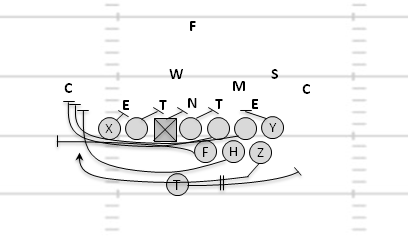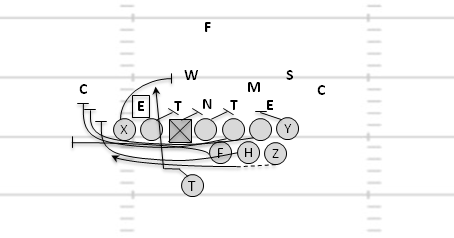Once it had faded away, the formation remained largely forgotten for decades, with the exception of a few holdout Single Wing teams, particularly Notre Dame Box teams, who used it as a changeup. A related system, the Fat Offense, was created by coach Bruce Eien as a changeup to his spread offense, though the Fat uses a balanced line and a wingback, and it's possible that Eien got the idea from Calande.
While other coaches may have dabbled in the formation, Coach Calande deserves the most credit by far for popularizing it. Now a guru of the Double Wing offense (and 46 Bear defense), he adopted the formation when he was transitioning from a Power-I offense to the Single Wing, unveiling his (re)creation on the internet and at Single Wing coaching conventions in the early 2000's. By the time he saw the formation in Tom Flores' book Football: The Violent Chess Match, he was already using several formations with multiple blocking backs, having been inspired by Pennsylvania powerhouse Central Bucks West. Coach Calande used the BEAST formation for two plays and one motivational technique, all of which I copied when I was coaching at Sarah T. Reed High School. The two plays he created were the "Blast" and "Power":
The Blast play makes the implied threat of the BEAST concrete with an isolation run behind three lead blockers, plus a pulling guard.
On the Power play the tailback runs behind the blocking of all three backs and both pulling tackles.
The motivational technique was called the "BEAST of the week." Whichever offensive or defensive lineman had the best week of practice and the best game in a given week got to carry the ball in the BEAST formation the following game. With linebackers subbed in as the blocking backs, our beast of the week would take the snap needing a yard for a first down and would often pick up seven or ten. Watching a lineman run over and through opposing defenses convinced me that this formation could do much more, and maybe even serve as a full-time offense, if combined with some modern passing concepts. Here are three ideas for an expanded Yale formation offense.
A quick note on line shifting
Regardless of the running and passing schemes used, a formation that so radically concentrates its power on one side of the formation has an opportunity to make good use of pre-snap shifting. If I were running this as my offense, I would use six formations: each combination of balanced line, 4x2 unbalanced line each way, and with the backs set to either side. I would shift from one to the other pre-snap to try to outflank and confuse the defense, which should already be uncomfortable unless you're playing a bunch of football historians. To get the line to shift as fast as possible, I would have them slide up and down the line of scrimmage as a unit, rather than having a tackle move all the way across the formation by himself. Basically, just like this.
Concept 1: Sweep/Counter Offense
Before there was the modern indirect-snap Double Wing offense of Hugh Wyatt, Jerry Vallotton, and Don Markham (and Steve Calande), there was the old-school direct-snap Double Wing offense Pop Warner used at Stanford and Carlisle. That scheme had relatively little plunging power, but created a devastating attack based on sweeps, counters, fake counters, reverses, double reverses, and reverse passes. The Yale formation could be used in much the same way. Once the Blast and Power plays forced the defense to crowd the middle, the power sweep would be in order:
The power sweep then sets up the inside counter to the outermost blocking back, which is really just the Power play with a little added deception:
The counter in turn sets up the reverse, which is just the power sweep except the roles of Z, X, and T are exchanged. (Note this is a true reverse rather than just an end around, which tends to get called a reverse on TV for some reason.)
The reverse then sets up the reverse pass (and the double reverse, if you want). The tailback (or shotgun quarterback) is usually left uncovered here:
Concept 2: Buck Lateral
A staple of many Single Wing offenses, the buck lateral series adds some ball-hiding deception to the Yale's power attack. After the tailback takes the snap and charges forward, he can keep the ball himself or hand it to the innermost blocking back, who has turned to face the backfield. The F back can then keep or hand off to the Z back looping around:
Because the Yale formation has only one deep back, this buck lateral series doesn't actually include a lateral, instead serving as something closer to the buck sweep series from the Wing-T. It might not be the stuff of the Mad Magicians, but when combined with the power game and the shifting line, the deception of a basic buck lateral series should unsettle most defenses.
Because the Yale formation has only one deep back, this buck lateral series doesn't actually include a lateral, instead serving as something closer to the buck sweep series from the Wing-T. It might not be the stuff of the Mad Magicians, but when combined with the power game and the shifting line, the deception of a basic buck lateral series should unsettle most defenses.
Concept 3: Power Read Option
But the read option provides a better way to get the same effect. Making the play a read keeps the defense from guessing correctly, and introducing the element of option gives defenders another responsibility to juggle. The extra blockers and defenders to the strong side could confuse the read there, so it's probably best to read the weakside edge defenders with a reversed read play:
The read play invites the defense to try to direct the play toward an overload. That sets up the power inverted veer:
The pulling linemen on the inverted veer can run inside or outside of the defensive end based on his technique.
And the weakside flood route:
Passing Game
Whether a Yale formation offense chooses one of the above three running schemes, or something else entirely, the formation also offers plenty of options for dropback passing. Even though none of the receivers are split from the formation, all five are on or near the line of scrimmage. The shortside tight end is a structural issue most defenses rarely see, and the blocking backs form a natural bunch with the strong tight end. Even if the F back is permanently required to help in weakside protection, the Yale formation provides plenty of options for the bunch passing game. The basic bunch series consisting of mesh (Coverdale and Robinson version), stem/chair, and shallow cross provides three versatile attacks that all look similar to each other initially:
Stem/chair punishes teams looking for mesh, but also provides a horizontal stretch and three good man-beaters.
Shallow cross provides a three level vertical stretch and four man-beating routes in a weakside sneak attack.
As defenses adapt to the proliferation of spread offenses by using fewer linemen and more hybrid defenders, offenses have the opportunity to swing the pendulum back the other way with more blockers for the power running game. The three running schemes and the basic pass series shown here are just a few of the ways that the Yale formation could be used to swing the pendulum way, way back. Just don't forget to reward your linemen, especially the BEAST of the week.
More Yale/BEAST resources:
Youth coach John T. Reed wrote an article about the Yale and the related under-center "Crunch" formation. He also mentions Flores' book, and the potential of the buck lateral series.Coach Darrin Hicks of Delta State University wrote about using the Yale formation for a sweep and a blast-like wedge play.
Coach Calande wrote an article about the BEAST for Double Wing Illustrated, issue #2.

















I am writing a new book on trick pays ! my first was published in 1996 called'Frist book of trick and special plays" . i would like to use some of your comments and diagrams on the BEAST FORMATION". I will give you full credit and add your blog address too. i have put together a book that is a lot like an unabridged dictionary huge. beside having over 150 contributors its over 300 pages long. let me know at pgwyatt@yahoo.com.
ReplyDeleteGreat work.
ReplyDeleteThanks
Perfect.
ReplyDeleteThank you
I looked this formation up from the old Yale glory days, ran a basic set of plays at the summershine tournament with my 7u dominated with 2 plays. Found this after doing more research and this sir is pure gold.
ReplyDeleteI use four plays from this for my 2 point conversions at the high school level. Last season we were 83% on conversions. That was with two freshmen and two sophomores on online.
ReplyDelete